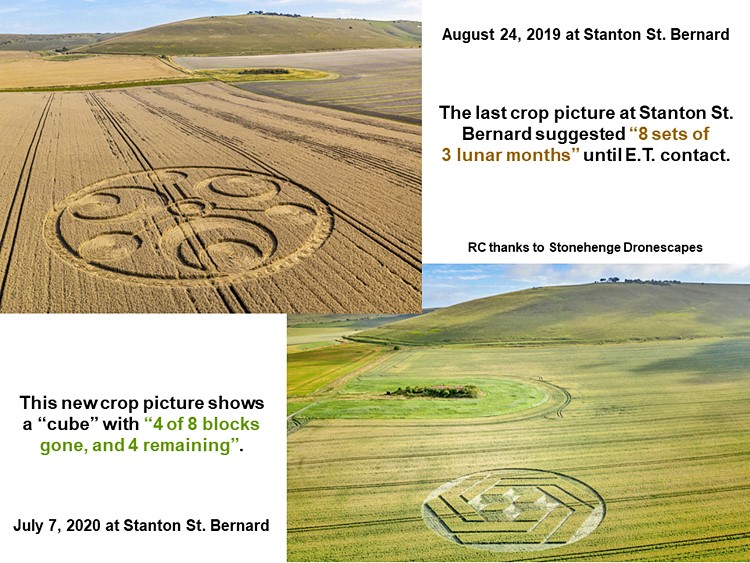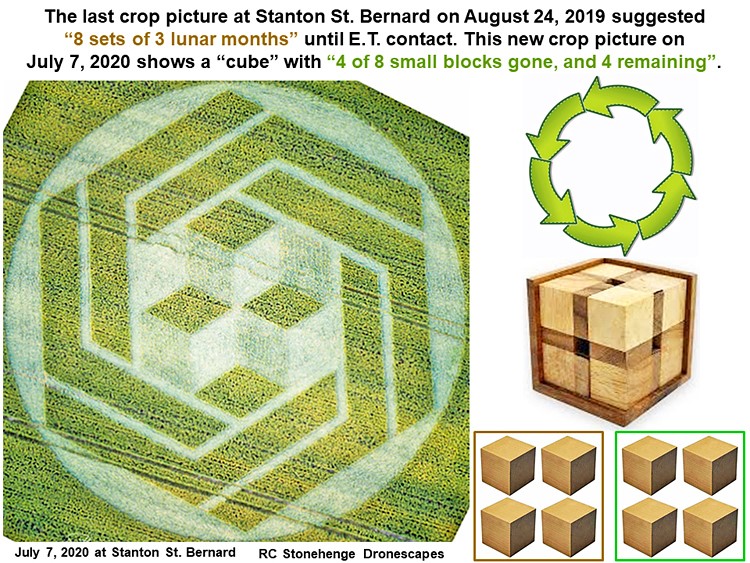|
What might
be the significance of two complex crop pictures which appeared with
similar field locations, near Stanton Saint Bernard in Wiltshire on
August 24, 2019 then July 7, 2020?
Both of
these crop pictures seem to show “calendar clocks”, which suggest when
the E.T. crop artists might finally arrive on Earth.
Their first
field drawing on August 24, 2019 showed a “calendar clock” with 88 days
per turn, equivalent to one orbit of planet Mercury around our Sun, or
three lunar months of 29.5 days each. We suggested at the time that this
crop picture, since it appeared on a date of August 24 or “8 / 24”,
might be suggesting 8 sets of 3 lunar
months or 24 lunar
months, until the crop artists may arrive (see
stanton articlesl).
Their new
field drawing on July 7, 2020 now shows another style of “calendar
clock” in the form of a “rolling cube”. This image has been drawn often
in crops as a metaphor for the passage of time, for example at Waden
Hill on April 22, 2017 (see
wadenhill2017a) or at Boreham Wood on July 1, 2017 (see
/boreham2017a).
We can
deduce, from a careful study of landscape alignments at Stanton St.
Bernard as shown in the first slide below (or as may be seen using
Google Earth), that their new “calendar clock” has
“rolled along”
relative to the old one, during an interval of 11 months from
August 2019 to July 2020, past a thin, vertical separation of two
neighbouring fields:

Both
“calendar clocks” from 2019 or 2020 lie below an “arrow-shaped” group of
trees in the landscape, one on the left-hand side of that “arrow”, and
the other on its right-hand side. Furthermore, as may be deduced by
studying a broad view shown on Google Earth, the precise direction of
motion when going from August 2019 to July 2020 is
toward the Milk Hill “White Horse”,
which lies in the distance several kilometres away.
If this
“calendar clock” keeps “rolling along” from 2020 to 2021, then it will
come into linear alignment with the “head” of that “arrow-shaped” group
of trees, approximately 11 months from now during May or June of 2021.
Now as may
be seen in a second slide below, the crop artists have also provided a
second and very-clever way of timing their possible, near-future arrival
on Earth, other than field geometry itself. Thus they have subdivided
their central “cube” into “8 small
blocks”, which match in number the original set of
“8 x 3 lunar months” which
were suggested by their “calendar clock” of August 24, 2019. They have
drawn that 8-part “cube” just as if 4
of its blocks had already been removed (through the
passage of time from August 2019 to July 2020), while
4 other blocks still remain
(until the crop artists arrive):

Both of
these artistic metaphors, namely (1) field geometry and (2) cubic
geometry, might possibly seem to suggest another 11 months, until the
E.T. crop artists actually arrive and show themselves in our skies? July
7, 2020 lies 317 days past August 24, 2019, while May 20, 2021 lies 317
days past July 7, 2020.
Finally,
certain detailed features of this new field drawing, notably 4
diamond-shaped wedges (each of which are made from approximately 12 x 12
= 144 standing-tufts of wheat) would seem to preclude any possibility of
local human construction.
Red Collie
(Dr. Horace R. Drew)
P.S. Many
thanks to Nick Bull of Stonehenge Dronescapes for wonderful aerial
images.
P.S.S. The
number of standing tufts in each of four, partly-flattened,
diamond-shaped sections near the centre of this crop picture would seem
to be approximately 10 x 13 =130, arranged in 10 rows of
13 standing tufts each.
If we
consider “130” to be a number in octal base-8, then its
decimal base-10 equivalent would be “88”.
This would
match “88 weaves” that were drawn around a nearby crop picture at
Stanton Saint Bernard on August 24, 2019. |